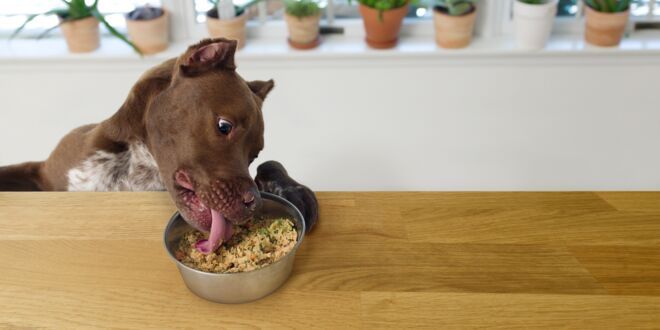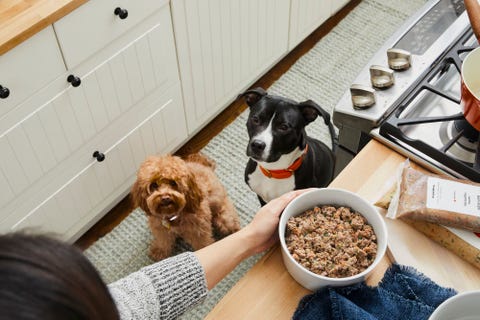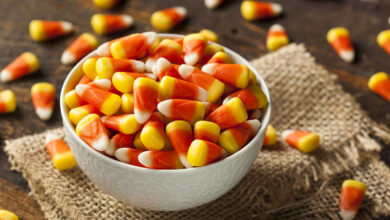8 Things Your Dog’s Poop May Be Trying to Tell You

Do you ever wish you could sit down and have a conversation with your pup? You’d ask how they feel, they’d tell you, and you’d know how to help. That kind of back-and-forth may not be feasible—at least for those of us who aren’t animal communication pros—but there is a way to glean a thing or two about your pet’s health. The answer is in their poop.
“It’s important to be aware and observant of changes in consistency and color,” says Dr. Amanda Williams, chief veterinarian and medical director of Furry Friends Adoption, Clinic & Ranch in Jupiter, Florida. A dog’s stool can tell you a few things about their overall wellness and point toward certain medical conditions.
Healthy dog stool should be shaped like a log of wood and retain that shape. It should also be moist and compact, yet easy to pick up from the ground as a solid piece. But what if their poop doesn’t look normal? Scroll down to see what your dog’s poop may be trying to tell you.
They’re Dehydrated, Possibly Constipated
Small, hard, round droppings can be a sign your dog is not drinking enough water and/or eating enough fiber, which could lead to constipation.
“Sometimes your veterinarian might recommend adding more dietary fiber via a high-fiber diet or a fiber supplement,” Williams says. “Other recommendations might include a laxative to help with stool passage or daily canned pumpkin with each meal to help with better bowel movement regulation. It’s always best to find the right balance to the stool to keep your dog feeling great.”
Digestion Issues May Be at Play
Perhaps your dog’s poop suddenly takes on a liquid consistency. This is consistent with diarrhea, which could signify a more serious intestinal problem and some trouble in the digestion department.
“You should make an appointment with your vet,” Williams recommends. If possible, bring a poop sample for the doctor to test and analyze. At the very least, bring a photo of it.
When pups are prone to diarrhea or other stomach sensitivities, fine-tuning their nutrition may be in order. Since not all dogs respond the same way to the same adjustments, it can be beneficial to personalize a meal plan for them. This is something you can do at The Farmer’s Dog, a subscription service that delivers personalized meal plans with pre-portioned servings based on your specifications. Their recipes are developed with board-certified veterinarians and made with human-grade ingredients that are preservative-free.
Their Colon May Be Inflamed
If your dog experiences stress, has food sensitivities, or has been diagnosed with inflammatory bowel disease, they could be prone to colon inflammation, something that can result in mucus and/or blood in the stool.
“The inflammation that develops in the colon can result in reduced water absorption and a decreased ability to store feces in the colon until a normal bowel movement passes,” Williams says. “This can result in frequent, small amounts of diarrhea, often with mucus or blood. The same mechanism can occur with food sensitivities or allergies, such as a chicken or beef sensitivity, and with inflammatory bowel disease.”
If your dog develops chronic diarrhea with mucus, blood, or both, schedule an appointment with your veterinarian for a full physical exam, baseline blood work, a fecal analysis, and any additional testing if warranted.
“The diarrhea can be treated with anti-diarrheals in most cases, but sometimes, a dog may need some anti-anxiety medication for acute or chronic stress control,” says Williams. “They may also need a food or diet change to eliminate an allergen from their daily intake or a more aggressive treatment for chronic inflammation of the colon and intestines.”
They’re Eating Too Much Grass
Dogs are known for snatching up grass as a snack, but not all do it because they enjoy the taste. In fact, many only eat it when they feel stressed or are trying to settle an upset stomach. When a dog consumes too much grass, it will be visible in their stool.
“If it’s present in excessive amounts, your veterinarian may need to treat the condition causing them to eat grass,” says Williams. This is especially true “if there are other signs of stomach upset, such as vomiting, diarrhea, or inappetence.” A dog who is eating grass as a result of not feeling well will typically have additional symptoms.
Once the root cause is fixed—be it a stomachache, a stressor like separation anxiety, or an underlying condition—your dog will stop eating grass or, at least, eat less of it. Until then, supervise them while outside and limit their grass intake.
“Dogs are known for snatching up grass as a snack, but not all do it because they enjoy the taste. In fact, many only eat it when they feel stressed or are trying to settle an upset stomach.”
Hair Loss May Be an Issue
“Fur and hair will be present in the stool if your dog is losing excessive amounts or licking themselves a lot,” says Williams.
“Many skin issues cause licking and hair loss, specifically food allergies, environmental allergies, fleas, and skin parasites. Some dogs may obsessively lick themselves either in one spot or in various spots due to stress, anxiety, and obsessive compulsion.”
Speak to a vet or dog dermatologist about underlying skin issues that may cause this behavior, as hair in the stool could lead to a blockage or more severe intestinal issues.
“Your veterinarian can help to differentiate between an allergy and a psychological reason behind the licking and recommend appropriate treatment,” says Williams.
Your Pup Has a Tapeworm
If your dog eats a flea that’s carrying a tapeworm larva, the tapeworm—a type of parasite—can transfer to their body and appear in your dog’s stool.
“You may see what looks like small, white grains of rice in the poop or longer thread-like white worms (up to 8 inches) if tapeworms or other parasites are present in your dog,” says Williams.
Spotting this warrants a trip to the vet. The doctor may screen for additional fecal parasites, such as hookworms, whipworms, and roundworms.
“Most of the time, the worms people see are tapeworms. Dogs pass only the microscopic eggs of the other parasites, and they are not visible without a microscope,” says Williams.
There May Be Internal Bleeding
Red blood or what looks like coffee grounds is a danger sign. If you spot anything like them, an immediate trip to the veterinarian or emergency clinic is warranted. It’s a red flag that can indicate internal bleeding.
“Red blood in the stool can sometimes be caused by intestinal parasites called hookworms or by an external issue,” says Williams. “If you see red streaks in their stool, have a fecal run by your veterinarian and check their hind end for cuts, wounds, and lacerations. As the feces exits, it may collect blood from a cut on the way out. Anal gland ruptures or infections can also cause blood to be noted on the surface of a bowel movement.”
“Black and tarry usually will indicate that there is bleeding in the stomach or the small intestine close to the stomach, and it is most commonly due to stomach ulceration,” says Williams. “It can be seen with gastrointestinal bleeding due to certain anti-inflammatory pain medications or rat poison ingestion. This is a very serious condition and the dog should be seen immediately if ever noted.”
A thorough exam, fecal testing, and any other necessary diagnostics can help determine the exact cause.
There’s an Issue With Their Pancreas or Liver
“Greasy or oily and gray stools can be present with malabsorption and maldigestion, which can happen when the pancreas does not produce the enzymes the body needs for proper digestion,” Williams says. “This condition is called exocrine pancreatic insufficiency, or EPI for short.”
Lack of bile in the stool can also cause gray discoloration, which again goes back to abnormal digestion and malabsorption. Sometimes, your pup may have orange and/or yellow stool. This can indicate a bile or liver condition, which can be caused by disease or something picked up in the environment.
Dogs can also develop cirrhosis of the liver. Anything that affects the liver’s ability to filter toxins from the bloodstream can lead to malfunction of the liver and orange stools,” Williams says. “Bile duct obstruction can lead to cholestasis, which means the bile is not draining properly. Inflammation of the gallbladder and gallstones can cause this discoloration as well.”
A Vet Can Always Help
Whenever you have concerns about your dog and their bathroom habits—which can include changes in color, volume, frequency, consistency, or comfort level while passing stool—have your dog examined by your veterinarian.
“Don’t just assume it might be something they ate or something just to monitor,” Williams cautions. “Your veterinarian will be able to make appropriate treatment recommendations, dietary recommendations, or additional testing recommendations to make sure your dog stays as healthy as possible.”
When it comes to a dog’s digestion and poop, there is a very real benefit to a fresh food diet. It can help prevent issues before they start. Learn more about The Farmer’s Dog and its freshly made, all-natural dog food here.
This content is created and maintained by a third party, and imported onto this page to help users provide their email addresses. You may be able to find more information about this and similar content at piano.io
Source link




